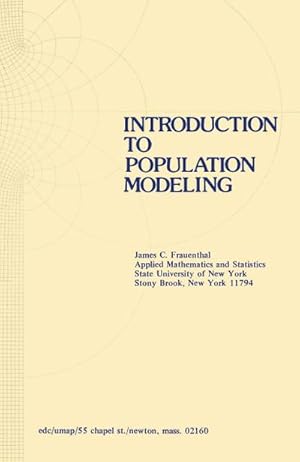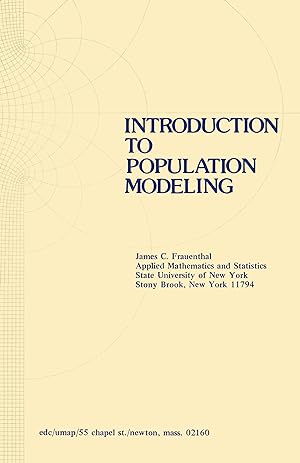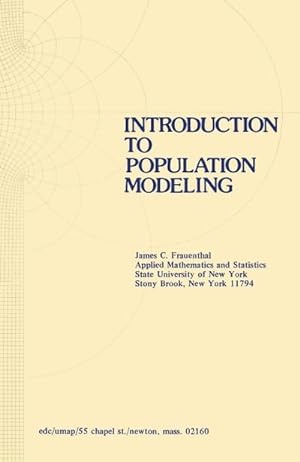introduction population modeling de frauenthal j c (12 resultados)
Filtros de búsqueda
Tipo de artículo
- Todos los tipos de productos
- Libros (12)
- Revistas y publicaciones (No hay ningún otro resultado que coincida con este filtro.)
- Cómics (No hay ningún otro resultado que coincida con este filtro.)
- Partituras (No hay ningún otro resultado que coincida con este filtro.)
- Arte, grabados y pósters (No hay ningún otro resultado que coincida con este filtro.)
- Fotografías (No hay ningún otro resultado que coincida con este filtro.)
- Mapas (No hay ningún otro resultado que coincida con este filtro.)
- Manuscritos y coleccionismo de papel (No hay ningún otro resultado que coincida con este filtro.)
Condición Más información
- Nuevo (11)
- Como nuevo, Excelente o Muy bueno (No hay ningún otro resultado que coincida con este filtro.)
- Bueno o Aceptable (1)
- Regular o Pobre (No hay ningún otro resultado que coincida con este filtro.)
- Tal como se indica (No hay ningún otro resultado que coincida con este filtro.)
Encuadernación
- Todas
- Tapa dura (No hay ningún otro resultado que coincida con este filtro.)
- Tapa blanda (12)
Más atributos
- Primera edición (No hay ningún otro resultado que coincida con este filtro.)
- Firmado (No hay ningún otro resultado que coincida con este filtro.)
- Sobrecubierta (No hay ningún otro resultado que coincida con este filtro.)
- Con imágenes (5)
- No impresión bajo demanda (8)
Idioma (1)
Precio
- Cualquier precio
- Menos de EUR 20 (No hay ningún otro resultado que coincida con este filtro.)
- EUR 20 a EUR 45 (No hay ningún otro resultado que coincida con este filtro.)
- Más de EUR 45
Gastos de envío gratis
- Envío gratis a Estados Unidos de America (No hay ningún otro resultado que coincida con este filtro.)
Ubicación del vendedor
Valoración de los vendedores
-
Introduction to Population Modeling (Modules and Monographs in Undergraduate Mathematics and Its Applications)
Librería: Ria Christie Collections, Uxbridge, Reino Unido
EUR 57,57
EUR 13,63 gastos de envío desde Reino Unido a Estados Unidos de AmericaCantidad disponible: Más de 20 disponibles
Añadir al carritoCondición: New. In.
-
EUR 55,70
EUR 17,62 gastos de envío desde Reino Unido a Estados Unidos de AmericaCantidad disponible: 10 disponibles
Añadir al carritoPF. Condición: New.
-
Introduction to Population Modeling
Librería: Kennys Bookshop and Art Galleries Ltd., Galway, GY, Irlanda
EUR 67,90
EUR 10,50 gastos de envío desde Irlanda a Estados Unidos de AmericaCantidad disponible: 15 disponibles
Añadir al carritoCondición: New. 1979. Paperback. . . . . .
-
Introduction to Population Modeling (Modules and Monographs in Undergraduate Mathematics and Its Applications)
Librería: Revaluation Books, Exeter, Reino Unido
EUR 77,26
EUR 11,38 gastos de envío desde Reino Unido a Estados Unidos de AmericaCantidad disponible: 2 disponibles
Añadir al carritoPaperback. Condición: Brand New. 1st edition. 186 pages. 8.50x5.51x0.47 inches. In Stock.
-
Introduction to Population Modeling
Librería: Kennys Bookstore, Olney, MD, Estados Unidos de America
EUR 84,27
EUR 9,09 gastos de envío en Estados Unidos de AmericaCantidad disponible: 15 disponibles
Añadir al carritoCondición: New. 1979. Paperback. . . . . . Books ship from the US and Ireland.
-
EUR 58,39
EUR 61,35 gastos de envío desde Alemania a Estados Unidos de AmericaCantidad disponible: 1 disponibles
Añadir al carritoTaschenbuch. Condición: Neu. Druck auf Anfrage Neuware - Printed after ordering - The text of this monograph represents the author's lecture notes from a course taught in the Department of Applied Mathematics and Statistics at the State University of New York at Stony Brook in the Spring of 1977. On account of its origin as lecture notes, some sections of the text are telegraphic in style while other portions are overly detailed. This stylistic foible has not been modified as it does not appear to detract seriously from the readability and it does help to indicate which topics were stressed. The audience for the course at Stony Brook was composed almost entirely of fourth year undergraduates majoring in the mathematical sciences. All of these students had studied at least four semesters of calculus and one of probability; few had any prior experience with either differential equations or ecology. It seems prudent to point out that the author's background is in engineering and applied mathematics and not in the biological sciences. It is hoped that this is not painfully obvious. -vii- The focus of the monograph is on the formulation and solution of mathematical models; it makes no pretense of being a text in ecology. The idea of a population is employed mainly as a pedagogic tool, providing unity and intuitive appeal to the varied mathematical ideas introduced. If the biological setting is stripped away, what remains can be interpreted as topics on the qualitative behavior of differential and difference equations.
-
EUR 50,35
EUR 70,00 gastos de envío desde Alemania a Estados Unidos de AmericaCantidad disponible: 5 disponibles
Añadir al carritoTaschenbuch. Condición: Neu. Introduction to Population Modeling | J. C. Frauenthal | Taschenbuch | xvi | Englisch | 1979 | Birkhäuser | EAN 9780817630157 | Verantwortliche Person für die EU: Springer Basel AG in Springer Science + Business Media, Heidelberger Platz 3, 14197 Berlin, juergen[dot]hartmann[at]springer[dot]com | Anbieter: preigu.
-
Introduction to Population Modeling (Modules and Monographs in Undergraduate Mathematics and Its Applications)
Librería: Mispah books, Redhill, SURRE, Reino Unido
EUR 97,27
EUR 28,45 gastos de envío desde Reino Unido a Estados Unidos de AmericaCantidad disponible: 1 disponibles
Añadir al carritoPaperback. Condición: Very Good. Very Good. book.
-
Introduction to Population Modeling
Librería: THE SAINT BOOKSTORE, Southport, Reino Unido
EUR 66,68
EUR 15,53 gastos de envío desde Reino Unido a Estados Unidos de AmericaCantidad disponible: Más de 20 disponibles
Añadir al carritoPaperback / softback. Condición: New. This item is printed on demand. New copy - Usually dispatched within 5-9 working days 290.
-
Introduction to Population Modeling
Librería: moluna, Greven, Alemania
EUR 48,37
EUR 48,99 gastos de envío desde Alemania a Estados Unidos de AmericaCantidad disponible: Más de 20 disponibles
Añadir al carritoCondición: New. Dieser Artikel ist ein Print on Demand Artikel und wird nach Ihrer Bestellung fuer Sie gedruckt. The text of this monograph represents the author s lecture notes from a course taught in the Department of Applied Mathematics and Statistics at the State University of New York at Stony Brook in the Spring of 1977. On account of its origin as lecture notes.
-
Introduction to Population Modeling
Publicado por Birkhäuser Boston Jan 1979, 1979
ISBN 10: 0817630155 ISBN 13: 9780817630157
Idioma: Inglés
Librería: BuchWeltWeit Ludwig Meier e.K., Bergisch Gladbach, Alemania
EUR 85,59
EUR 23,00 gastos de envío desde Alemania a Estados Unidos de AmericaCantidad disponible: 2 disponibles
Añadir al carritoTaschenbuch. Condición: Neu. This item is printed on demand - it takes 3-4 days longer - Neuware -The text of this monograph represents the author's lecture notes from a course taught in the Department of Applied Mathematics and Statistics at the State University of New York at Stony Brook in the Spring of 1977. On account of its origin as lecture notes, some sections of the text are telegraphic in style while other portions are overly detailed. This stylistic foible has not been modified as it does not appear to detract seriously from the readability and it does help to indicate which topics were stressed. The audience for the course at Stony Brook was composed almost entirely of fourth year undergraduates majoring in the mathematical sciences. All of these students had studied at least four semesters of calculus and one of probability; few had any prior experience with either differential equations or ecology. It seems prudent to point out that the author's background is in engineering and applied mathematics and not in the biological sciences. It is hoped that this is not painfully obvious. -vii- The focus of the monograph is on the formulation and solution of mathematical models; it makes no pretense of being a text in ecology. The idea of a population is employed mainly as a pedagogic tool, providing unity and intuitive appeal to the varied mathematical ideas introduced. If the biological setting is stripped away, what remains can be interpreted as topics on the qualitative behavior of differential and difference equations. 208 pp. Englisch.
-
Introduction to Population Modeling
Publicado por Birkhäuser Boston, Birkhäuser Boston Jan 1979, 1979
ISBN 10: 0817630155 ISBN 13: 9780817630157
Idioma: Inglés
Librería: buchversandmimpf2000, Emtmannsberg, BAYE, Alemania
EUR 53,49
EUR 60,00 gastos de envío desde Alemania a Estados Unidos de AmericaCantidad disponible: 1 disponibles
Añadir al carritoTaschenbuch. Condición: Neu. This item is printed on demand - Print on Demand Titel. Neuware -The text of this monograph represents the author's lecture notes from a course taught in the Department of Applied Mathematics and Statistics at the State University of New York at Stony Brook in the Spring of 1977. On account of its origin as lecture notes, some sections of the text are telegraphic in style while other portions are overly detailed. This stylistic foible has not been modified as it does not appear to detract seriously from the readability and it does help to indicate which topics were stressed. The audience for the course at Stony Brook was composed almost entirely of fourth year undergraduates majoring in the mathematical sciences. All of these students had studied at least four semesters of calculus and one of probability; few had any prior experience with either differential equations or ecology. It seems prudent to point out that the author's background is in engineering and applied mathematics and not in the biological sciences. It is hoped that this is not painfully obvious. -vii- The focus of the monograph is on the formulation and solution of mathematical models; it makes no pretense of being a text in ecology. The idea of a population is employed mainly as a pedagogic tool, providing unity and intuitive appeal to the varied mathematical ideas introduced. If the biological setting is stripped away, what remains can be interpreted as topics on the qualitative behavior of differential and difference equations.Springer Basel AG in Springer Science + Business Media, Heidelberger Platz 3, 14197 Berlin 208 pp. Englisch.







